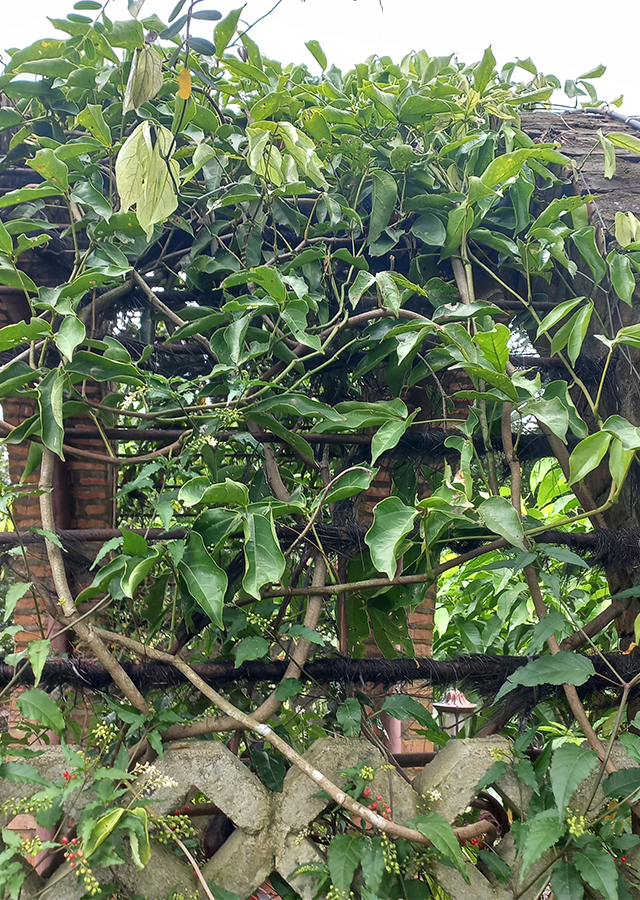Jade Vine
Strongylodon macrobotrys A.Gray
Fabaceae
Location in our garden
Principal



Synonym
Strongylodon megaphyllus Merr.
Strongylodon warburgii Perkins
Habitus
Climbers. Perennials vines, lianas, with stems that can grow to a length of 18 m
Part Used
Leaves
Flowers
Stem
Growing Requirements
Full Sunshine
Need Shade
Habitat
Riverbanks
Forest
Terrestrial
Overview
Jade vine or Strongylodon macrobotrys is native to the Philippines. In its native area, this species is widely cultivated as an ornamental plant and is considered one of the most beautiful plants due to its elegant and striking turquoise color and the flowers that hang in the air when in full bloom. This makes Jade vine much sought after by lovers of ornamental plants. However, the existence of this plant is becoming increasingly rare in the wild due to habitat destruction and has resulted in this plant having a vulnerable conservation status and is included in the IUCN threatened species list. In addition to its beauty, this plant turns out to have health benefits. Based on research, it is known that Jade vine has compounds with biological activities that show anticancer properties.
Vernacular Names
Tayabak (Philippines), Lu yu teng (Chinese), Cascada de Jade (Spanis).
Agroecology
Jade vine is found thriving in tropical forests, along rivers or in ravines from 700 to 1,000 m above sea level. This species grows well in fertile, well-drained soil, with soil acidity (pH) conditions slightly acidic to neutral (pH 6 - 7). Jade vines will grow best if the roots are in the shade, while the leaves receive full sun.
Morphology
- Roots - tap root.
- Stems - woody, has a gray bark and smooth, round, strong.
- Leaves - trifoliate (consisting of 3 leaves), light green in color, oval in shape, pinnate leaf bone, flat leaf edge, pointed leaf tip (acuminate), leaf base is obtuse. The tendril stalk is relatively wide, about 2.5 cm wide.
- Flowers - bisexual, claw-shaped flower crown or bird beak with a unique bluish-green color similar to the colors of minerals such as turquoise and jade. The sepals form an arch. The flower stalk or pedicellus is short and attached to the flower arrangement. Flowers are arranged in long hanging inflorescences known as independent coils or pseudoracemes (1.5 - 3 m long), 75 or more flowers. Inflorescences is flors terminalis.
- Fruits - the pods are fleshy, oval or round, have a short curly beak at the apex, the fruit is green. In 1 fruit consists of up to 12 seeds.
- Seeds - light brown, oval in shape.
Cultivation
Propagated by seeds and stem cuttings.
Chemical Constituents
Taraxerone, stigmasterol, ß-sitosterol, triglycerides, ß-stigmasteryl 3-O-ß-D-glucopyranoside, polyprenol, lutein, squalene, chlorophyll, malvin (anthocyanin), and saponarin (flavone glucoside).
Traditional Medicinal Uses
Has activity as anticancer.
Part Used
Reference Sources
- Royal Botanic Gardens, Kew. Plants of the World Online: Strongylodon macrobotrys A.Gray. https://powo.science.kew.org/taxon/urn:lsid:ipni.org:names:519595-1. 23-08-22.
- Flora Fauna Web. 2022. Strongylodon macrobotrys. https://www.nparks.gov.sg/florafaunaweb/flora/1/5/1506. 23-08-22.
- Stuartxchange. 2021. Philippine Medicinal Plants: Tayabak. http://www.stuartxchange.org/Tayabak. 23-08-22.
- Ragasa C. Y. et al. 2014. Chemical constituents of Strongylodon macrobotrys. Der Pharma Chemica, 2014, 6 (6):366-373. http://derpharmachemica.com/archive.html.


